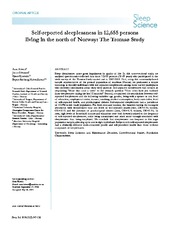| dc.contributor.author | Fetveit, Arne | en_US |
| dc.contributor.author | Straand, Jørund | en_US |
| dc.contributor.author | Bjorvatn, Bjørn | en_US |
| dc.contributor.author | Kristoffersen, Espen Saxhaug | en_US |
| dc.date.accessioned | 2020-08-04T13:07:36Z | |
| dc.date.available | 2020-08-04T13:07:36Z | |
| dc.date.issued | 2019 | |
| dc.Published | Fetveit A, Straand J, Bjorvatn B, Kristoffersen ES. Self-reported sleeplessness in 12,655 persons living in the north of Norway: The Tromsø Study. Sleep Science. 2019;12(3):147-155 | eng |
| dc.identifier.issn | 1984-0659 | |
| dc.identifier.issn | 1984-0063 | |
| dc.identifier.uri | https://hdl.handle.net/1956/23411 | |
| dc.description.abstract | Sleep disturbances cause great impairment in quality of life. In this cross-sectional study, we analysed questionnaire-collected data from 12,655 persons (30-87 years) who participated in the sixth survey of the Tromsø Study carried out in 2007-2008. First, using this community-based sample representative of the general population of northern Norway, we performed a simple screening to identify individuals with self-reported sleeplessness among those survey participants who provided information about their sleep patterns. Self-reported sleeplessness was defined as responding “More than once a week” to the research question “How often have you suffered from sleeplessness during the last 12 months?” Second, we analysed the associations between selfreported sleeplessness and the following variables: age, gender, living with a spouse or not, level of education, employment status, income, smoking, alcohol consumption, body mass index, level of self-reported health, and psychological distress. Self-reported sleeplessness had a prevalence of 12.6% in this study population. For both men and women, the variables having the strongest association with sleeplessness were low levels of self-reported health (men, OR=8.70; women, OR=5.73) and the presence of psychological distress (men, OR=4.15; women, OR=2.76). In men, high levels of household income and education were both inversely related to the frequency of self-reported sleeplessness, while being unemployed was much more strongly associated with sleeplessness than being employed. We conclude that sleeplessness was frequent in this large population sample, affecting up to one in eight individuals. Subjects with self-reported sleeplessness had a distinctly different socio-economic profile and self-perceived health than those without complaints of sleeplessness. | en_US |
| dc.language.iso | eng | eng |
| dc.publisher | Brazilian Sleep Society | eng |
| dc.relation.uri | https://pdfs.semanticscholar.org/a067/32185ea8e00a02ac582f0a19647bc44a19ee.pdf?_ga=2.194684650.654504909.1581283263-2028772803.1581283263 | |
| dc.rights | Attribution-NonCommercial-NoDerivs CC BY-NC-ND | eng |
| dc.rights.uri | http://creativecommons.org/licenses/by-nc-nd/4.0/ | eng |
| dc.title | Self-reported sleeplessness in 12,655 persons living in the north of Norway: The Tromsø Study. | en_US |
| dc.type | Peer reviewed | |
| dc.type | Journal article | |
| dc.date.updated | 2020-02-10T10:32:50Z | |
| dc.description.version | publishedVersion | en_US |
| dc.identifier.doi | https://doi.org/10.5935/1984-0063.20190070 | |
| dc.identifier.cristin | 1766718 | |
| dc.source.journal | Sleep Science | |

